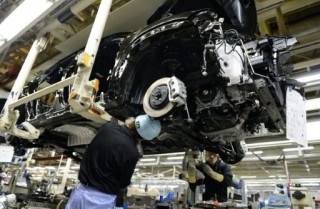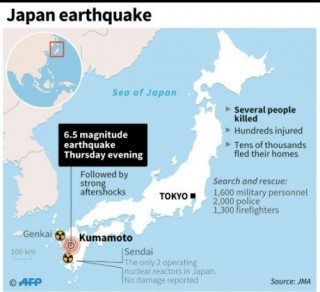Loading
Search
▼ Plants Shut Down After Quake, Fueling Economic Fears
- Category:Other
TOKYO — Some of Japan’s biggest firms including Sony and Toyota shut down operations in southern Japan Friday after the region’s deadly earthquake, but analysts said while the economy could be affected the impact would be far less than previous disasters.
At least nine people were killed in Thursday night’s 6.5-magnitude quake, which also toppled houses and buckled roads on the southwestern island of Kyushu.
With widespread damage to infrastructure, several companies—including in the steel, auto and technology sectors—said they had temporarily ceased production.
Exporter giants Toyota, Honda and Sony were carrying out safety checks to assess possible damage to plants and those of suppliers.
Other firms shutting down included Mitsubishi Electric, Renesas and Fujifilm as well as tire maker Bridgestone and beverage titan Suntory Holdings.
Sony shares ended down more than 3%, Toyota lost 1.1% and Honda was off 1% while Bridgestone lost 0.5%.
However, the broader Nikkei stock index ended just 0.4% lower, with some of the losses also attributable to profit-taking after a strong rally this week.
Minister of Economy, Trade and Industry Motoo Hayashi told reporters that there had not been the devastation that tore into northern Japan after the 2011 quake.
At least nine people were killed in Thursday night’s 6.5-magnitude quake, which also toppled houses and buckled roads on the southwestern island of Kyushu.
With widespread damage to infrastructure, several companies—including in the steel, auto and technology sectors—said they had temporarily ceased production.
Exporter giants Toyota, Honda and Sony were carrying out safety checks to assess possible damage to plants and those of suppliers.
Other firms shutting down included Mitsubishi Electric, Renesas and Fujifilm as well as tire maker Bridgestone and beverage titan Suntory Holdings.
Sony shares ended down more than 3%, Toyota lost 1.1% and Honda was off 1% while Bridgestone lost 0.5%.
However, the broader Nikkei stock index ended just 0.4% lower, with some of the losses also attributable to profit-taking after a strong rally this week.
Minister of Economy, Trade and Industry Motoo Hayashi told reporters that there had not been the devastation that tore into northern Japan after the 2011 quake.
“There are some companies that have stopped operations, but so far I’ve received no reports of the huge impact we had” in the March, 2011 quake, he said, according to Jiji Press
That quake unleashed a deadly tsunami that swallowed schools and entire neighborhoods, killing more than 18,000 people and triggered reactor meltdowns that released radiation.
It also led to the closure for several months of dozens of factories, decimating the country’s production capacity and sending shockwaves through the already struggling economy.
Shattered supply chains and rolling power shortages forced companies such as Sony and Toyota to temporarily shut plants in the weeks after the disaster and Japan’s industrial output tumbled by its largest amount on record in the March.
Many component manufacturers were based in the worst-hit regions and the disaster led to a call for firms to spread their operations to avoid a repeat of the widespread shutdown that hammered economic growth.
“Overall damage is so far concentrated in Kumamoto,” said Harumi Taguchi, economist at IHS Economics in Tokyo.
“If (the) supply chain had gotten damaged due to train and road conditions… the influence could spread to neighboring prefectures and other regions,” she said in a message to AFP.
She added, however, that compared to the 1996 earthquake in Kobe and the 2011 disaster “damage is probably quite limited”.
Still, the latest quake comes as the economy struggles to get on track, with the government’s much-lauded growth drive stumbling.
“Japan’s economy has weak growth momentum and remains in a fragile state with the absence of a powerful and sustained engine for growth,” Yasunari Ueno, chief market economist at Mizuho Securities in Tokyo, told Bloomberg News. “Any unexpected powerful shock could push the nation into a recessionary phase.”
© 2016 AFP
That quake unleashed a deadly tsunami that swallowed schools and entire neighborhoods, killing more than 18,000 people and triggered reactor meltdowns that released radiation.
It also led to the closure for several months of dozens of factories, decimating the country’s production capacity and sending shockwaves through the already struggling economy.
Shattered supply chains and rolling power shortages forced companies such as Sony and Toyota to temporarily shut plants in the weeks after the disaster and Japan’s industrial output tumbled by its largest amount on record in the March.
Many component manufacturers were based in the worst-hit regions and the disaster led to a call for firms to spread their operations to avoid a repeat of the widespread shutdown that hammered economic growth.
“Overall damage is so far concentrated in Kumamoto,” said Harumi Taguchi, economist at IHS Economics in Tokyo.
“If (the) supply chain had gotten damaged due to train and road conditions… the influence could spread to neighboring prefectures and other regions,” she said in a message to AFP.
She added, however, that compared to the 1996 earthquake in Kobe and the 2011 disaster “damage is probably quite limited”.
Still, the latest quake comes as the economy struggles to get on track, with the government’s much-lauded growth drive stumbling.
“Japan’s economy has weak growth momentum and remains in a fragile state with the absence of a powerful and sustained engine for growth,” Yasunari Ueno, chief market economist at Mizuho Securities in Tokyo, told Bloomberg News. “Any unexpected powerful shock could push the nation into a recessionary phase.”
© 2016 AFP
- April 20, 2016
- Comment (0)
- Trackback(1)



